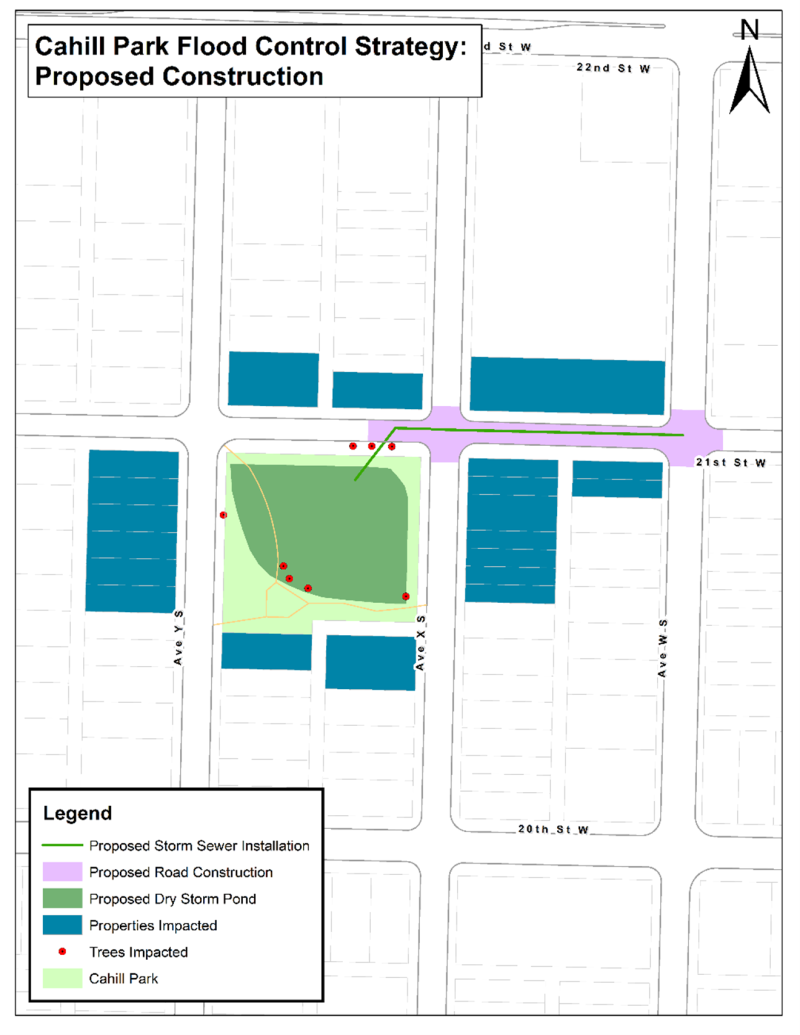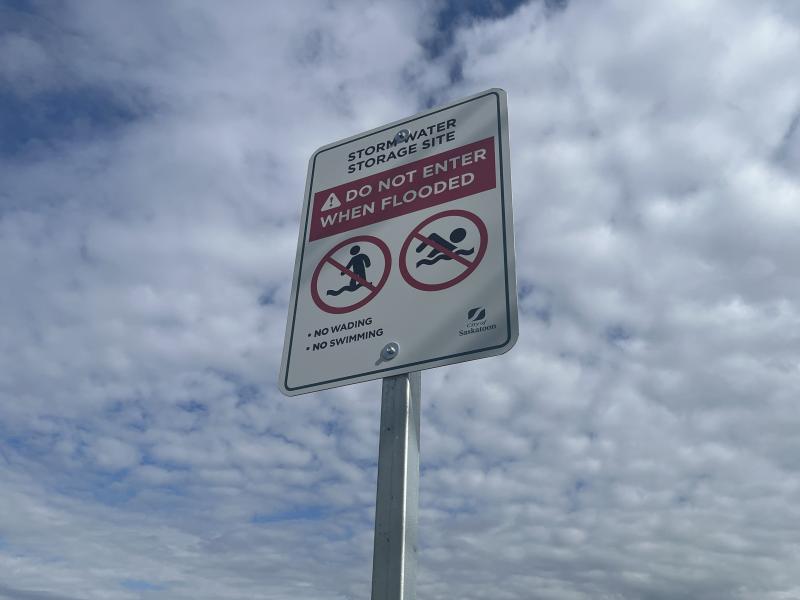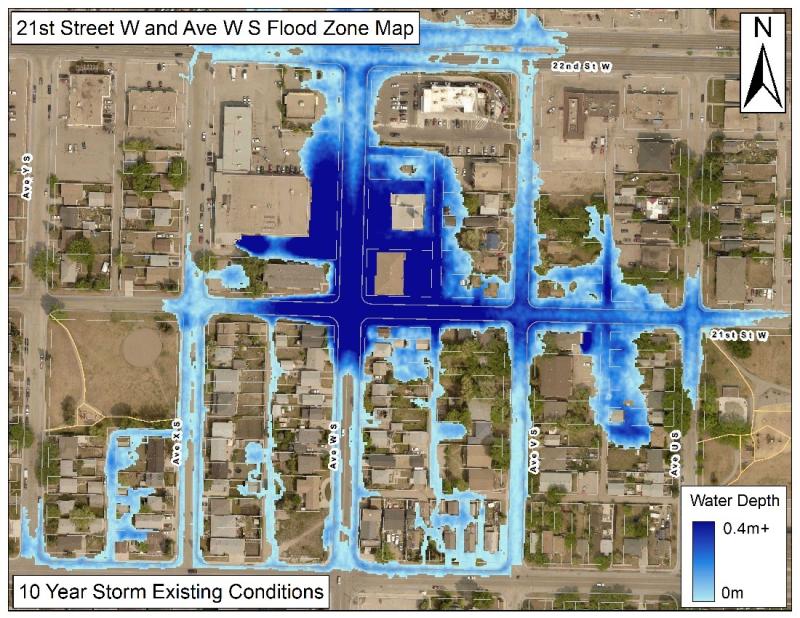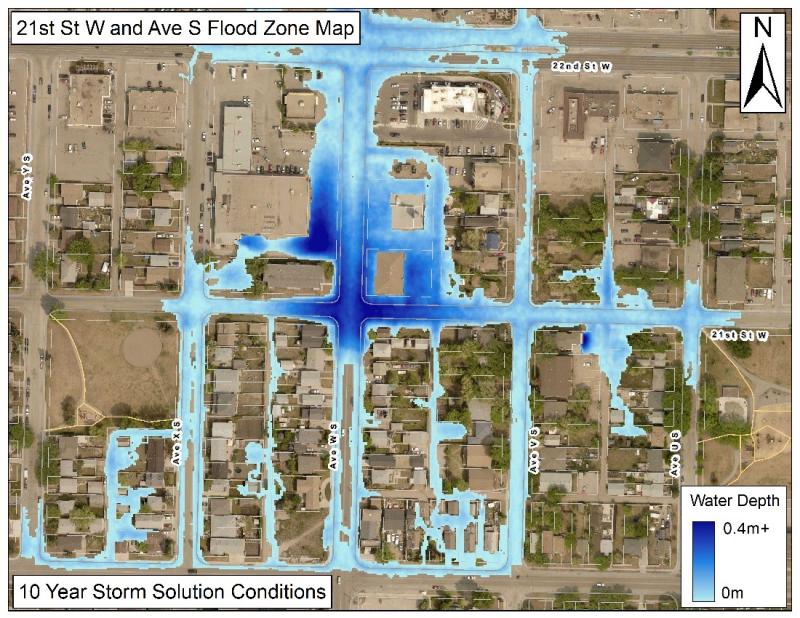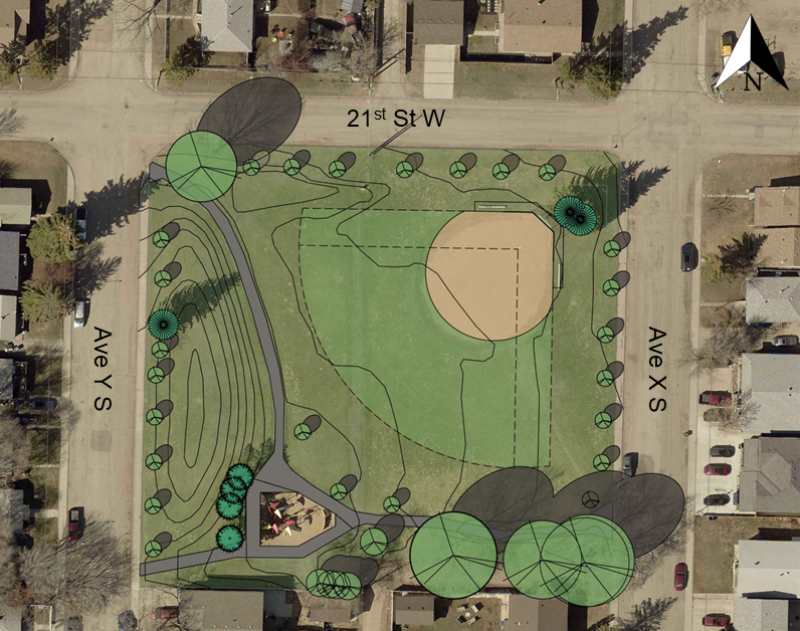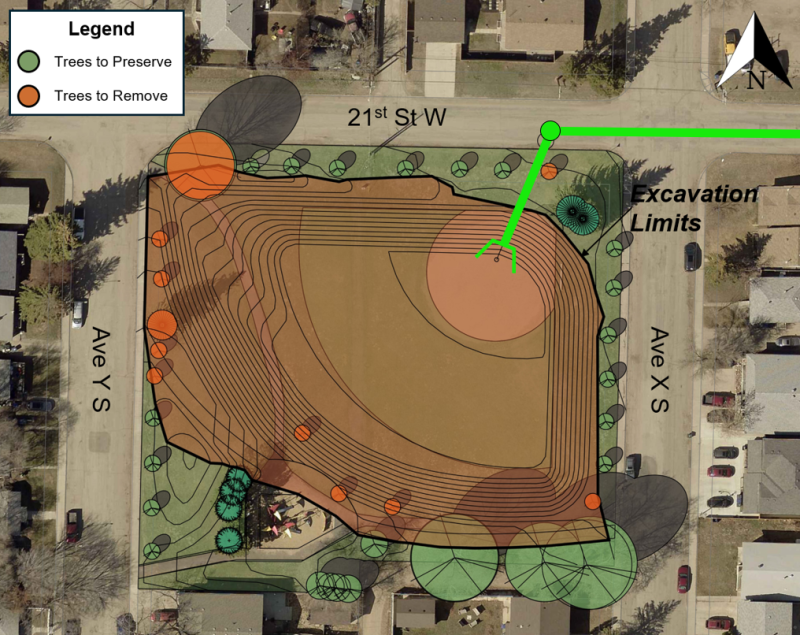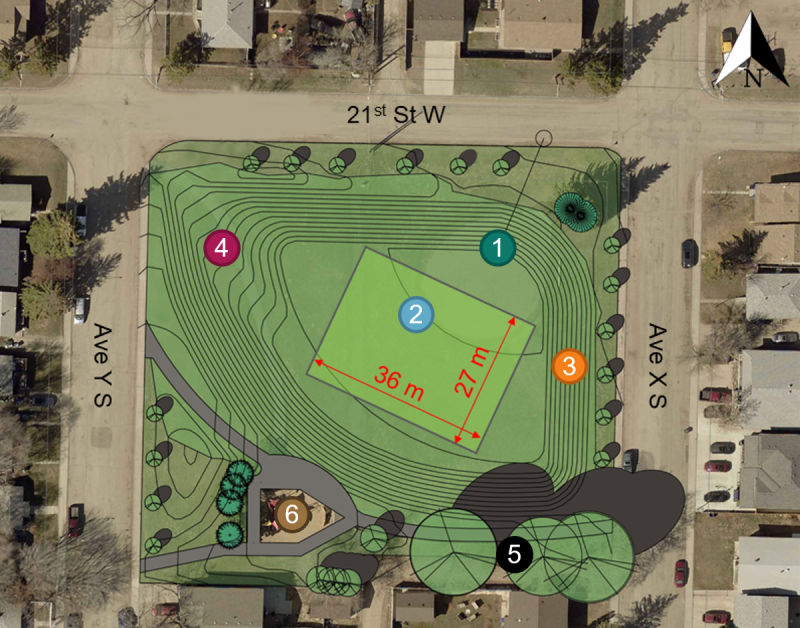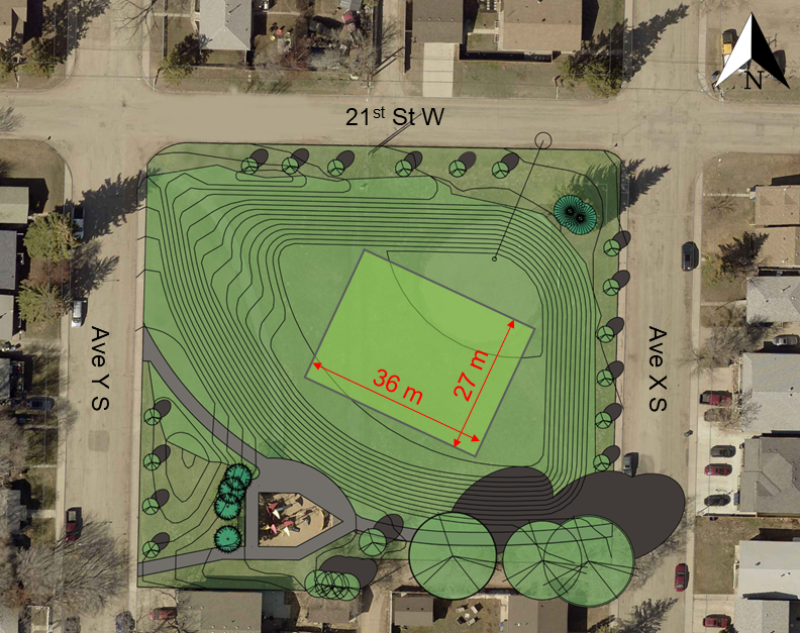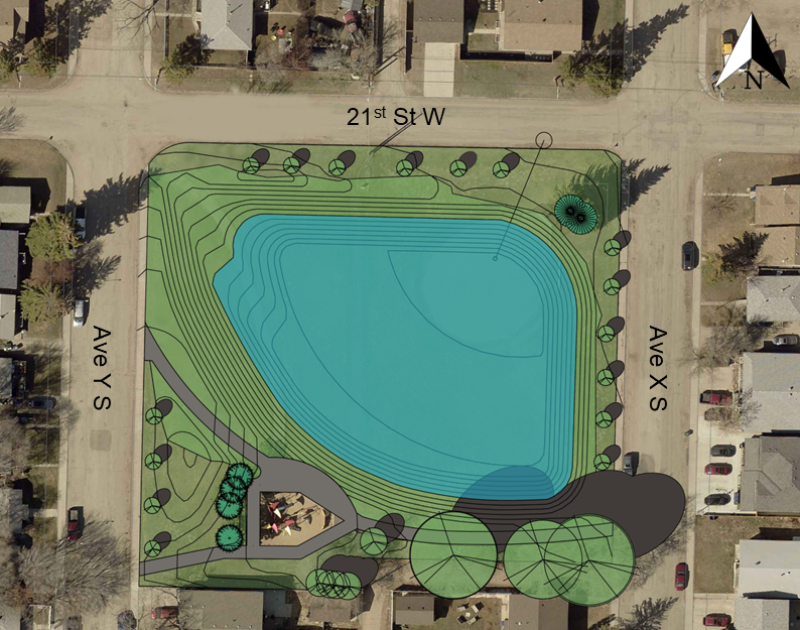What changes are planned for Cahill Park?
A new dry pond will be constructed in Cahill Park, along with storm infrastructure improvements near 21st Street West and Avenue W South. Historically, flooding has occurred in this area with at least 10 buildings experiencing flooding during a 1-in-10 year storm. This new project will reduce flood risk and future flooding expected with climate change at the intersection of 21st Street West and Avenue W South and surrounding areas.
What is a dry pond?
A dry storm pond, or dry pond, is a storage area that temporarily holds rainwater during intense rain events. The water is stored in the pond temporarily before it drains back into the underground pipe system. It is different from a wet pond in that most of the time the dry pond will not hold any water and can be used as park space.
How will Cahill Park be impacted?
Along with the construction of the dry storm pond in Cahill Park, a new storm sewer will be installed from the intersection of 21st Street West and Avenue W South to the dry pond in Cahill Park.
The existing ball diamond located in Cahill Park will be removed as part of this project. Alternative recreational uses (such as a multi-purpose field) within the park will be explored during the detailed design phase of the project, with feedback from residents and stakeholders being considered in the final design.
The existing playground area will remain in place and unchanged as a result of this project.
In addition, a Crime Prevention through Environmental Design review will be completed to identify areas of the park design that can minimize crime while still being accessible to the community.
When will construction occur?
Construction- February 2026 to October 2026
Landscaping Establishment – Estimated Fall 2026 to Fall 2027
Park Reopens to Public – Estimated Fall 2027
What areas will be impacted by construction?
Below is a map displaying the construction areas.
Will the park be available for use during construction?
Cahill Park will not be available to the public during construction and landscape maintenance period. Construction fences will be installed around the work area.
The project team currently plans that the playground area will remain open during construction, though this may change as the project progresses through detailed design. The public will be informed of the final decision regarding anticipated playground status during construction.
Will there be a permanent fence around the dry pond?
The City will not install a permanent fence around the dry pond to keep the park inviting for use most of the time when the dry pond bottom is not holding water. While there will be a safety risk from the water during and immediately following intense rain events, a fence also creates safety risks of falls and entrapment. Fences also detract from aesthetics, can catch debris, and require frequent maintenance. Fences should only be used when their risk reduction and advantages outweigh the additional risks and disadvantages.
Signage will be posted around the dry pond to alert park visitors of the potential safety risks when the dry pond is flooded.
Will trees be impacted by the project?
Approximately 8 trees will be removed during construction of the dry pond. Replacement trees will be planted as part of the project. If further tree removal is required, appropriate stakeholders will be informed, and the project will provide necessary compensation as outlined in City Council Policy C09-011 Trees on City Property.
What is the Flood Control Strategy?
If you've ever experienced flood damage, you know how devastating it can be. Though parts of Saskatoon have always been susceptible to flooding, and flood protection measures to date have helped, climate change is expected to bring more frequent and intense storms.
In December 2018, the City Council approved implementation of the nine-year $54 million Flood Control Strategy to mitigate flooding in ten areas that experience frequent flooding. Cahill Park is the seventh area receiving upgrades as part of this Strategy. Visit the Flood Control Strategy page for more information.
Why is there such a high risk of flooding in this area?
Flooding only occurs during significant rain events. Neighbourhoods developed prior to 1989 were not constructed to the same standards and storage we install today. Significant rain events are now managed through wet and dry ponds, which can collect high volumes of storm water.
How often will the dry pond have water in it?
The Cahill Dry Pond will be designed to hold water that would otherwise be flooding streets and nearby properties during intense rain events. This will be confirmed in the detailed design; however, water can be expected to enter the pond once or twice a year on average. Water is designed to drain out of the dry pond within 24 hours after a rain event, depending on the storm’s intensity. A layer of sub-drainage will be constructed as an additional measure to ensure that drainage meets standards while also considering geotechnical conditions and irrigation benefits.
How will this project impact the risk of flooding in the area?
The Dry Storm Pond will provide approximately 3,700 m3 of storm water storage. This will reduce the flood risk of up to 10 buildings near the intersection of 21st Street West and Avenue W South. Instead of storm water ponding on the street and entering nearby basements, the storm water will be transported to Cahill Dry Pond, mitigating flooding in this area.
The map below displays flood risk in the area under current conditions in the event of a 1 in 10-year storm, followed by a map displaying the flood risk during a 1 in 10-year storm once the dry pond and additional storm water infrastructure are in place.
How is the project being funded?
In 2019, the Government of Canada (Government) approved 40% cost sharing of the Flood Control Strategy's total estimated eligible expenses of $54.1 million, up to a maximum of $21.6 million through the Disaster Mitigation and Adaptation Fund. The City approved Storm Water Utility funding of $32.4 million through previously approved increases to the Storm Water Management Charge to cover the other 60% of the expenses. The City’s Storm Water Utility will fund any cost overages of the FCS through capital reserve allocations if required.
The Cahill Park project is estimated to cost $4.4 million with the City contributing 60% ($ 2.6 million) and the Government through the Disaster Mitigation and Adaptation Fund is contributing 40% ($1.8 million).

